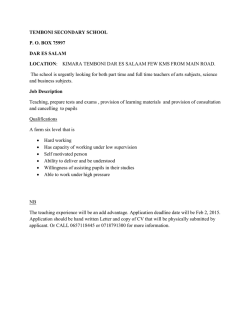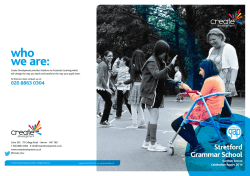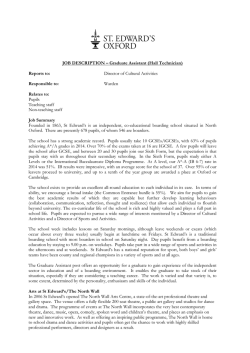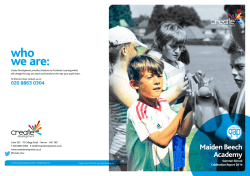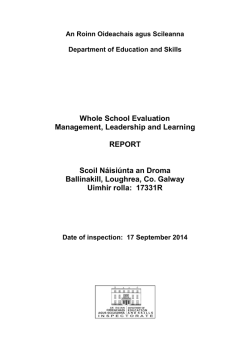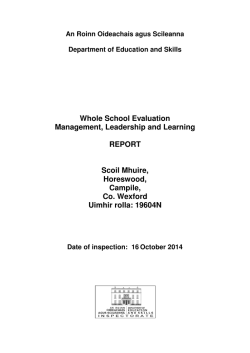
School Accessibility Plan 2014-16
Sir Thomas Abney Primary School School Accessibility Plan 2014-16 We all shine Our School Sir Thomas Abney is ‘A good school that helps everyone to do their best’ (Ofsted Report June 2007) We pride ourselves on being an inclusive school, where we celebrate diversity and difference and acknowledge the richness that this brings to our school community. We aim to provide opportunities for all children to access a broad, balanced and creative curriculum, regardless of age, attainment, ethnicity, language or background that is personalised to meet children’s individual needs. Introduction The SEN and Disability Act 2001 extended the Disability Discrimination Act (DDA) to cover education. From 2002, the Governing Body has three key duties towards disabled pupils, under Part 4 of the DDA: Not to treat disabled pupils less favourably for a reason related to their disability; To make reasonable adjustments for disabled pupils, so that they are not at a substantial disadvantage; To plan to increase access to education for disabled pupils. What do we mean by ‘Disability’ The DDA defines a disabled person as someone who has: ‘a physical or mental impairment which has a substantial and long-term adverse effect on his or her ability to carry out normal day-to-day activities.’ ‘Long term’ means at least 12 months. ‘Substantial’ means ‘more than minor or trivial.’ Who would be covered under the definition of disability? Impairment Physical impairment – includes sensory impairment • Eczema in its severest form • Diabetes • Nut allergy • Severe asthma Pupils with a progressive condition such as: • Cancer • Multiple sclerosis • HIV infection are covered as soon as they have the condition and before there is necessarily any effect on their ability to carry out normal day to day duties. Pupils with a severe disfigurement do not have to prove that their impairment has a substantial adverse effect their ability to carry out day-to-day duties. School Accessibility Plan 2008-11 2 Mental impairment – includes learning difficulties and an impairment resulting from or consisting of a mental illness. It can include hidden impairments such as: • Dyslexia • Autism • Speech and language impairments • Attention deficit hyperactivity disorder (ADHD) • School Action Plus or Statemented children – (a child’s ability to memorise, concentrate, learn, speak, move is central to their education). An impairment that has a long term and substantial effect on a child’s ability to do these things may amount to a disability. Does the impairment affect normal day-to-day activity in one or more of the following? • Mobility; • Manual dexterity; • Physical coordination; • Continence; • Ability to lift, carry or otherwise move everyday objects; • Speech, hearing or eyesight; • Memory or ability to concentrate, learn or understand; • Perception of risk of physical danger; The person does not have to have a diagnosis in order to be considered as having a particular impairment. If the condition has a long term and substantial adverse effect on their ability to carry out normal day to day activities he/she would come under the definition It is important that staff are aware that, although a pupil, parent, carer or staff member may be considered to have a disability according to the definition, they may not consider themselves disabled. Key Objective This plan sets out the proposals of the Governing Body of Sir Thomas Abney School to increase access to education for disabled pupils in the three areas required by the planning duties in the DDA Increasing the extent to which disabled pupils can participate in the school curriculum, Improving the environment of the school to increase the extent to which disabled pupils can take advantage of education and associated services Improving the delivery to disabled pupils of information which is provided in writing for pupils who are not disabled School Aims When performing their duties all staff and governors are committed to offering high-quality education to all children in the community with regard to the Disability Rights Commission (DRC) Code of Practice (2002) and in line with the requirements of the SEN and Disability Act (2001). Compliance with the requirements of the DDA is key to all school policies. School Accessibility Plan 2008-11 3 All children are individuals and entitled to the best education they can receive regardless of any disability they may have. Access to Education means making a full school life accessible to the any disabled pupil, including any extracurricular activities and events. The school promotes inclusion and provides all pupils with a broad and balanced curriculum. It will take all reasonable steps to ensure that children with a disability or SEN are not discriminated against or treated less favourably than other pupils. The school will work in partnership with the family and other agencies in the best interest of the pupil to meet their individual learning requirements and maximise educational opportunity. The school recognises and values parents’ knowledge of their child’s disability and its effect on his/her ability to carry out normal activities. The school recognises the parents’ and child’s right to confidentiality. The school is committed to continuing staff training to enable them to be effective in the education of young people with disabilities and/or Special Educational Needs. The school is committed to prioritising sufficient resources to support the actions identified in this plan. In partnership with the Learning Trust we will consider improved access to the physical environment in all future planning e.g. carpeting to ease movement of wheelchairs and lift access to the second floor. Our commitment to inclusion At Sir Thomas Abney School we welcome and value all children no matter their special need or disability and strive to deliver a fully accessible social and academic curriculum. We have adapted systems and structures: curriculum, building, attitudes and values towards making our school a more ‘inclusive’ school. Equally important is our intention to make the school accessible to parents, carers and the wider community in order that they have access to meetings with teachers, social events and extended school activities. Dealing with barriers to inclusion We recognise that a child has special education needs if they have significantly greater difficulties in learning than the majority of children of the same age: some children have specific learning difficulties in certain areas of the curriculum; some have physical difficulties which affect their access to the curriculum. There ae a number of ways in which we continuously evaluate and monitor pupils at risk of disability and discrimination: A pupil support team comprising of Inclusion Manager, Learning Mentor, Lead teacher for Behaviour and Headteacher who meet once a term to discuss in-school support for identified children. Their aim is to help better the provision for the children and to monitor those who receive help from different initiatives in the school. School Accessibility Plan 2008-11 4 The Resources Committee meet once a term to discuss building and grounds issues, maintenance and accessibility, and to monitor the progress of items highlighted on the school improvement plan. For children with identified SEN, termly individual education plans (IEP) meetings are held between the Inclusion Manager, parent/carer, child, teacher to discuss how best to support the child’s access to the curriculum , whether it be physical, academic or emotional. Phase meetings are held weekly to ensure effective planning and monitoring of teaching and learning to ensure inclusion of all pupils regarding on and off-site activities. There are additional policies to inform provision and support for our children ie SEN and Inclusion Policy and Equal Opportunities Policy. Staff training The school’s Professional development policy covers the needs of all staff. Priorities are identified through the School Improvement Plan, Performance Management and in person with the Inclusion Manager. Training may take place in a variety of ways: Induction with relevant policies Attending courses held by the hackney Learning Trust School INSET days; Regular SEN meetings; Opportunities for discussions with outside professionals and specialist teachers eg SALT; Literature available on specific aspects of disability access. Facilities, resources and equipment Sir Thomas Abney has classrooms are located both on the ground and first floor, use of these classrooms can be rotated to meet pupils’ needs. The front and back entrances to the school are on the ground floor and ramps are in place at the main entrances on the ground floor where there are stairs. Portable ramps are available if needed in other places. The public-access rooms, including meeting rooms, toilets and hall are on the ground floor with ramp access. There are disabled toilets in the school and the MUGA facilities Some of our children have complex needs as well as visual and physical impairment. When necessary we provide appropriate furniture and toys such as chairs and toilet seats. The School Business Manager and Site Manager meet half termly to audit the school and grounds to identify barriers preventing access and inclusion to the entire curriculum. It is required that the school’s accessibility plan is resourced, implemented, reviewed and revisited as necessary. Attached is a set of actions showing how the school will address the priorities identified by this plan. School Accessibility Plan 2008-11 5 Linked Policies The plan will contribute to the review and revision of related school policies, The School Development Plan The School Conditions Report Action Plan The School Inclusion Policy The School Equal Opportunities Policy The School Teaching and Learning Policy Publicising the Plan This plan will be promoted and made available to existing or prospective parents by using the below methods: School Prospectus School Newsletters School Website School Accessibility Plan 2008-11 6 Accessibility Action Plan To ensure continued good accessibility, we will: Action Responsibility Increase the extent to which disable pupils can participate in the school curriculum. Enhance knowledge and confidence amongst staff on approaches to teaching pupils working below NC level1 by continuing professional development Maxine Ferguson Improve the environment of the school to increase the extent to which disabled pupils can take advantage of education. A gradual increase in the availability of physical aids to access the curriculum. Ensure accessibility is considered in all future purchase decisions of equipment and in building plans. Maxine Ferguson and Coral Wasylenczuk Improve the delivery to disabled pupils of information which is provided in writing for pupils who are not disabled. Provide visual prompts e.g. visual timetable and PED cards. Continue to develop bank of resources accessible in other formats (e.g. Braille, large print, audio) Maxine Ferguson School Accessibility Plan 2008-11 7 Date of Plan October 2014 Date of Review October 2016 Member(s) of Staff Responsible for Plan Maxine Ferguson Governor / Committee Responsible for Plan Lisa Neidich School Accessibility Plan 2008-11 8
© Copyright 2026
